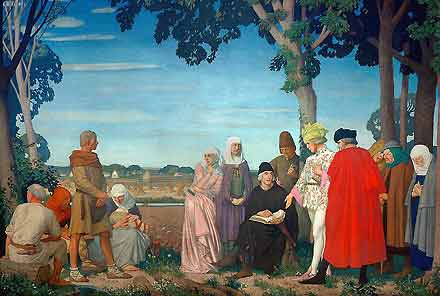The English people reading Wycliffe's Bible
© 2007
Armchair Travel Co. Ltd. - This page may be used for non-commercial purposes
ONLY!
![]()

[ Play
Narrated and Animated Movie ! ] John Wycliffe has been called the Morning Star of the Reformation, because in the second half of the 14th century he preached many doctrines which were to become, more than a hundred years later, central to the Reform Movement in the church. A learned man, he was famous as a philosopher before he became famous as a theologian, and famous as a theologian before he became notorious - at least to the authorities -as a heretic.
This picture commemorates one particular aspect of his work which casts a long shadow towards the future. Wycliffe was horrified how ignorant most ordinary people were of what the Bible actually says. He wanted the poor preachers who on his behalf travelled around the country to be able to correct this, and so started a translation of the Bible into English. He himself translated the Gospels into the English which Chaucer was at the same period using for the Canterbury Tales. As the painting shows, all over the country simple people gathered to hear the new translation read, despite many prosecutions for heresy.
This is one of eight monumental canvases commissioned in 1927 to fill the vacant spaces on the walls of St Stephen's Hall. The idea of this scheme was conceived by a committee including Lord Peel, Lord Crawford (Chairman of the Fine Arts Commission) and the Speaker of the House of Commons - at that time J.H. Whitley. The subjectmatter and artists were chosen by Sir Henry Newbolt, the unifying theme being 'The Building of Britain', during the eight centuries from King Alfred to Queen Anne. The result is an unusual attempt to produce in the 1920s High Art of the sort which was understood by the Victorian artists of the 19th-century Palace, of Westminster, but which was no longer popular or perhaps well understood.
[ Virtual
Tour ] [ Main Topics
Index ]

Additional Information on
The English people reading Wycliffe's Bible
Explore-Parliament.net: Advanced Category Search
Keyword Categories:
_Object_Painting
_Object_Artwork
_Event_Historical
_Setting_England
_Artist_Clausen
_Wycliffe